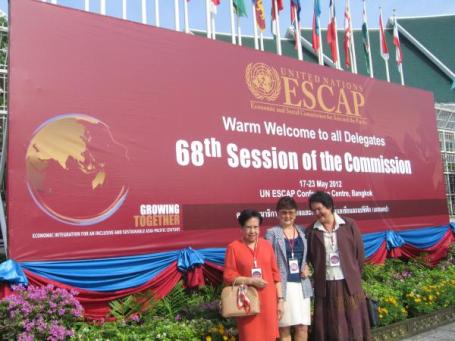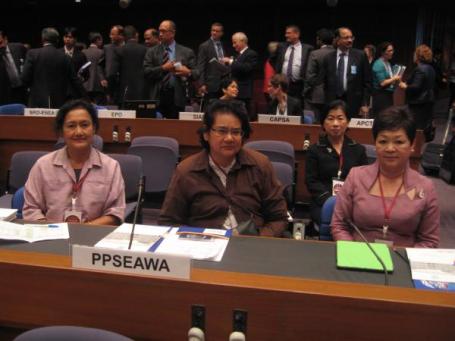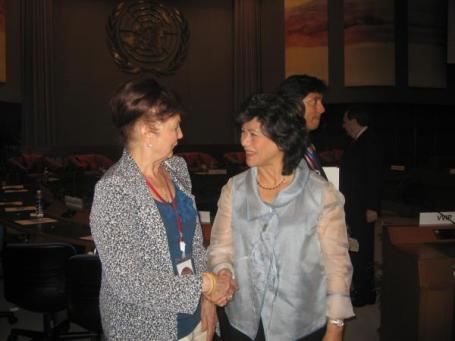


PPSEAWA International for many years has had a permanent representative to ESCAP, presently Dr, Chaiskran Hiranpruk, who attends these sessions on regular basis. In addition, PPSEAWA Thailand is also actively participating in this UN entity which focuses on the Asia/Pacific region.
This was the first time that I was able to attend one of these sessions dealing with the various issues that pertain to this area. The session is structured in two segments: a Senior Officials Segment, consisting of Committees and the Working group on a draft resolution, and a Ministerial Segment. The Ministerial roundtable theme topic was “Growing Together: Economic Interaction for an Inclusive and Sustainable Asia-Pacific Century” and the High-level Panel on “Steering inclusive development amidst global turbulence and volatility.” The last meeting was of a Special Body on Pacific Island developing Countries.
The opening address was given by Noleen Heyzer, Under-Secretary-General of the United Nations, who is also the Executive Secretary of ESCAP.
Below you will find a summary of one of the topics discussed. For detailed papers please go to http://www.unescap.org/commission/68/documents
Section I Macroeconomic policy and inclusive development
Introduction
4. The Asia-Pacific region is facing the challenge of coping with a global economic slowdown. Economic growth in the region is also expected to fall in 2012. This subprogramme will continue to explore policy options aimed at minimizing the adverse impact of deterioration in the global environment on countries of the region and maintain their growth momentum and macroeconomic stability. At the same time, the subprogramme will continue providing assistance on enhancing knowledge and strengthening the capacity of high-level policymakers on ways to build resilience against financial and economic shocks.
5. Another related challenge deals with commodity price volatility, which has raised concerns about inflation, hunger and poverty. In addition, the longer-term trend of rising commodity prices will have long lasting and even deeper consequences on developing countries in the region. How to address this challenge and turn it into an opportunity has been one of the main areas of work under this subprogramme. In this context, countries with special needs will remain priority of work under the subprogramme, especially helping these countries in achieving the Millennium Development Goals and implementing global and regional mandates.
6. The scope and outreach of CAPSA has significantly expanded since its renaming in 2012 to address the concerns of member countries on the role of sustainable agriculture in the fight against environmental degradation, food insecurity and poverty.
Key issues and challenges
A. Macroeconomic policy issues
7. The Asia-Pacific region is facing the challenge of coping with a sharp deterioration in the global environment. A substantial slowdown in growth in the region is expected in 2012, with the developed economies of the world remaining mired in the economic crisis which erupted in 2008. The impact on Asia-Pacific countries at this stage of the crisis has been on the financial markets through capital outflows due to risk aversion, and more fundamentally on growth due to shrinking demand for exports. The growth prospects in countries in the region diverge considerably depending on their reliance on the developed economies, with major exporting economies being the worst hit while domestic demand dependent economies remaining relatively robust. Although intraregional trade has been growing faster than the region’s trade with the rest of the world, the extent of replacement of growth in intraregional trade and demand remains too low in the short term to sufficiently make up for the sluggish recovery in the markets of the developed economies.
8. Apart from the trade challenge of global slowdown, the region has to be prepared for a worst-case scenario of a financial crisis emanating from the euro zone. As highlighted in the Economic and Social Survey of Asia and the Pacific, impacts could include a global credit crunch and substantial outflow of capital, as was the case in 2008. Many economies in the region continue to grapple with the challenge of historically high and volatile prices, influenced in substantial part by global factors such as food and oil prices and foreign capital inflows buoyed by global liquidity. Many countries in the region are now confronted with the dilemma of maintaining price stability in the face of a deteriorating global economic environment.
9. A number of countries in the region have also been severely impacted by the effects of natural disasters, which have taken lives and caused severe distress as well as negatively affected growth prospects and complicated economic management. In the latter half of 2011, severe floods beset Thailand, Viet Nam, Myanmar, the Lao People’s Democratic Republic and Cambodia in South-East Asia and Pakistan in South Asia, while typhoons took their toll on the Philippines. Governments in the disaster-hit countries can take the opportunity to invest in social sectors as part of recovery and reconstruction efforts, undertake new and strategic investments in the agriculture sector, as well as make improvements in urban planning and land use to reduce disaster risks.
10. The region is well-placed to counteract the growth pressure in the short term from the deteriorating global environment by undertaking fiscal and monetary stimulus, due to good macroeconomic fundamentals. Most countries in the region retain substantial budgetary space to be able to increase government spending. Interest rates, which are currently at relatively high levels across the region, can also be kept on hold or even decreased if necessary, which would stimulate lending across the region. In terms of the risk of financial turbulence due to the unstable global environment, stronger capital controls may be considered by governments. The medium-term challenge for the region is to sustain its development by reducing its dependence on developed economies which will remain sluggish for an extended period, by continuing to rebalance growth through inclusive policies which boost domestic and regional demand.
B. Issues related to poverty and inclusive development policy
11. Despite impressive economic growth in past decades, poverty continues to be a major challenge in Asia and the Pacific, particularly in the least developed countries. The global financial and economic crisis, coupled with higher food and commodity prices, aggravated the situation in many countries in the region. These recent developments were also a stark reminder that the problem of poverty cannot be tackled without closer attention to the broader macroeconomic environment, and that unless regional and international policy responses are in place, individual countries will remain as vulnerable to future crises as they were before.
12. In light of this, the secretariat has provided assistance on enhancing knowledge and strengthening the capacity of high-level policymakers on ways to build resilience against financial and economic shocks. A series of regional and subregional high-level dialogues stimulated policy debate on the most suitable economic policies for the ESCAP region and for countries at different stages of development. Issues discussed included the role of monetary policy amid supply shocks of higher food and commodity prices, the role of capital controls in response to large and volatile capital flows, and the role of fiscal, social and employment policies in supporting domestic growth amid global turbulence. In particular, the issue of financialization of commodity markets was highlighted and appropriate regulatory measures at the global level recommended.
13. As emphasized in the Economic and Social Survey of Asia and the Pacific 2012 Commodity price volatility has raised widespread concerns about inflation, hunger and poverty. At the same time, the longer-term trend of rising commodity prices may have long lasting and even deeper consequences. Commodity markets have been experiencing a boom since 2000 driven mainly by the rise of Asian economies, whose accelerated manufacturing-led growth has increased the demand for all sorts of primary products. The boom has ended the secular decline in commodity terms of trade, which has important implications for the growth trajectory of developing countries and poses severe risks of increasing global disparities. To mitigate these risks, it is necessary to put in place national actions and an enabling international environment that promote and accept diversity of development strategies; prevent countries to fall prey to the natural resources curse; assist countries in building up their productive capacities and engaging in balanced economic integration; and protect the vulnerable from increasing hunger and poverty caused by high commodity prices by strengthening social protection and boosting agricultural productivity.
14. In light of the global financial and economic crisis, the Commission at its sixty-seventh underlined the need to effectively integrate the region’s priorities at the global level, and requested the secretariat to provide a platform for developing a strong and coordinated regional voice in international forums including the G20. The High-level Consultation the G20 Cannes Summit: Perspectives from Asia-Pacific, which was held in October 2011 was attended by 28 countries, including seven least developed countries from the region. In addressing issues of global reform from the region’s perspective, the high-level consultation sought to ensure that the voices of developing countries, including the least developed countries, are heard in global policy discussions. The consultation also sought to ensure that inclusive and sustainable development priorities are not overlooked but rather closely integrated into global macroeconomic, financial and regulatory policy initiatives put forth by the G20. The outcome of the consultation was communicated to the Secretary-General and the Sherpas (senior representatives) of the eight countries from the region represented in the G20, as well as to the G20 chair.
